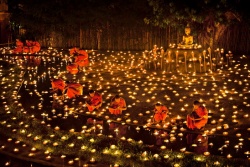Difference between revisions of "Insentient beings"
Jump to navigation
Jump to search
(Created page with "thumb|250px| <poem> '''insentient beings''' [非情] (Jpn hijo ) Those beings or objects that have no emotions or consciousness, such as trees and ston...") |
|||
| (3 intermediate revisions by 2 users not shown) | |||
| Line 1: | Line 1: | ||
[[File:60968.jpg|thumb|250px|]] | [[File:60968.jpg|thumb|250px|]] | ||
<poem> | <poem> | ||
| − | + | [[insentient beings]] | |
| − | |||
| − | + | [[非情]] (Jpn [[hijo]]) | |
| + | |||
| + | Those [[beings]] or [[objects]] that have no [[emotions]] or [[consciousness]] , such as [[trees]] and stones. The term is contrasted with [[sentient beings]] , those [[forms]] of [[life]] that possess [[senses]] , [[emotions]] , or [[consciousness]] . [[Buddhism]] classifies all [[existences]] into two categories: sentient and insentient. A dispute arose in [[Chinese Buddhism]] with regard to whether [[insentient beings]] possess a [[Buddha nature]] , but the [[view]] that [[Buddhahood]] [[exists]] as a potential in all things and [[phenomena]] prevailed in [[China]] . This [[idea]] also became widespread in [[Japan]] . See also [[enlightenment of plants]]. | ||
</poem> | </poem> | ||
{{R}} | {{R}} | ||
Latest revision as of 01:38, 24 January 2014
insentient beings
非情 (Jpn hijo)
Those beings or objects that have no emotions or consciousness , such as trees and stones. The term is contrasted with sentient beings , those forms of life that possess senses , emotions , or consciousness . Buddhism classifies all existences into two categories: sentient and insentient. A dispute arose in Chinese Buddhism with regard to whether insentient beings possess a Buddha nature , but the view that Buddhahood exists as a potential in all things and phenomena prevailed in China . This idea also became widespread in Japan . See also enlightenment of plants.
